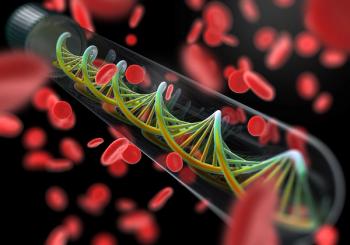
Oncogenes Driving Squamous Cell Lung Carcinoma
In this interview we discuss the oncogenes driving the development of squamous cell carcinoma of the lung, a type of non-small-cell lung cancer.
Today we are joined by Alan Fields, PhD, professor of pharmacology at the Mayo Clinic in Jacksonville, Florida. He is a cell and molecular biology researcher who heads a lab studying the genetics and biology of lung and colon cancers. We are also joined by Verline Justilien, PhD, a cancer biology researcher, also at the Mayo Clinic in Florida. Along with colleagues, Dr. Fields and Dr. Justilien recently
-Interviewed by
Cancer Network: Dr. Fields, can you describe the importance of the 3q26 aberration in squamous non–small-cell lung cancer and the questions you wanted to address with this current study?
Dr. Fields: Yes, of course, 3q26 is one of the most frequently observed genetic alterations in lung squamous cell carcinoma-specifically, the tandem amplification of this region. In fact, 70% to 80% of lung squamous cell carcinoma tumors appear to harbor alterations at this 3q26 locus. In addition, 3q26 amplification is associated with a poor outcome and, in particular, a high rate of relapse after therapy. Understanding how this 3q26 alteration drives lung squamous cell carcinoma disease has important implications for developing better treatments. What we wanted to do in this study was to address whether an oncogene we had identified, called protein kinase C or PRKCI, is involved in driving lung squamous cell carcinoma. We had previously demonstrated that this oncogene resides at 3q26 and had observed that PRKCI is required for the growth of lung cancer cells. Also, our previous data suggested that PRKCI may be important for maintaining a population of cells within tumors that are called tumor-initiating cells or cancer stem cells. Our goal with this study was to determine whether PRKCI was a relevant target of the 3q26 alteration in maintaining a stem cell population in this disease and if so, how does PKC iota (PKCι) maintain these cancer stem cells? And our studies provided answers to both of these questions.
Cancer Network: Dr. Justilien, what was the approach you took to understand the importance of this genetic alteration that Dr. Fields just described in this type of lung cancer and what were the results?
Dr. Justilien: We isolated and characterized a subpopulation of cancer cells that exhibit stem-like properties in lung squamous cell carcinomas. These cancer stem-like cells are shown to drive the initiation, maintenance, and metastasis of lung squamous cell carcinomas, and we actually found that PKCι maintains the properties of these stem-like cells. So, the aim of our study was to understand how PKCι actually maintains lung squamous cell carcinoma stem-like cells. We performed a genomic analysis and mRNA sequencing to quantitatively measure gene expression changes and PKCι-depleted lung squamous cell carcinoma stem-like cells. In essence, in one shot, we could determine all of the genes and cellular pathways in lung squamous cell carcinoma stem-like cells that require PKCι for their activation or repression. Once we identified these genes and pathways, the next step was to determine if any of the genes and pathways that are regulated by PKCι are also required for the maintenance of the lung squamous cell carcinoma stem-like phenotype.
One of the most interesting findings in the genomic analysis was that PKCι is able to regulate the activation of the Hedgehog signaling pathway. Hedgehog signaling is an evolutionarily conserved pathway that is absolutely critical for development, and the signaling has been found to be aberrantly activated in some human cancers. We found that, similar to PKCι, the components of the Hedgehog pathway that are regulated by PKCι are also required for lung tumor carcinoma cells to maintain their stem-like properties. Our results so far provide a possible mechanism by which the Hedgehog signaling can be aberrantly activated in human tumors. Given that the PKCι gene (PRKCI) resides in the 3q26 region, and actually a number of the genes in that region have also been implicated in human cancer, we next looked to see if any of the other genes in the 3q26 region were also involved in maintaining the stem-like properties of lung squamous cells. Interestingly, we found that the PKCι gene (PRKCI) and another gene called SOX2, which is in that region, are frequently co-amplified and co-overexpressed in human lung squamous cell carcinomas with amplified 3q26. SOX2 is a transcription factor and a master regulator of stem cell maintenance, and it too was previously identified as an oncogene in lung squamous cell carcinoma. And indeed, like PKCι, SOX2 is required for the maintenance of the stem-like properties of the lung squamous cells. And even more interestingly, we found that PKCι can phosphorylate SOX2 to activate the function of SOX2, and this phosphorylation event is required for the maintenance of these stem-like properties.
Perhaps one of the most significant findings of our study is that we identified a link between PKCι, SOX2, and Hedgehog signaling. We found that PKCι phosphorylation of SOX2 led to immediate upregulation of one of the Hedgehog signaling components, called HHAT, which is required for the rate-limiting step of the activation of the Hedgehog signaling pathway. We found that SOX2-mediated HHAT upregulation of this component actually drives Hedgehog pathway activation to drive the maintenance of the stem-like cells in lung squamous cell carcinoma. Overall from our study, we came to the following conclusions: One, that PKCι and SOX2 are genetically linked in that they are co-amplified in the 3q26 amplicon in lung squamous cell carcinoma. Two, PKCι and SOX2 are biochemically linked in that SOX2 serves as a substrate for PKCι phosphorylation. And three, PKCι and SOX2 are functionally linked in that they maintain the stem-like properties of these lung cancer cells to drive tumorigenesis.
Cancer Network: Dr. Fields, what are the implications of these results, and what are you and colleagues now working on next that’s related to this work?
Dr. Fields: I think there are several implications to this study. The first is with respect to 3q26 alteration in cells. This study provides a new level of understanding about how this genetic alteration can drive disease. It was suspected that multiple genes at 3q26 were actually the targets of this alteration and that they together would be involved in tumorigenesis, but what was really surprising in our findings was that not only are there multiple genes at this genetic locus that are involved, but these genes are not only genetically linked as Dr. Justilien mentioned, but that they are also functionally and biochemically linked and they are connected in driving disease. So, this may actually be a paradigm shift in our understanding of how relatively simple genetic alterations can drive, perhaps, a full signaling pathway that drives tumor development. And this may have implications for how other gene amplifications that are common in other types of tumors also work.
The second implication is with respect to PKCι itself. This study gives us an answer of how this oncogene participates in lung squamous cell carcinoma causation and indicates that, in fact, it is important in driving the disease. It also provides new mechanistic insights into how these lung cancer stem cells are maintained. Third, I think our study has important implications for the use of targeted therapeutics against PKCι for lung squamous cell carcinoma treatment. We are testing a PKCι inhibitor, called auranofin, which is actually a repurposed drug currently in the clinic. And more potent inhibitors of PKCι are in preclinical development. This study can hopefully help us to identify patients who are most likely to respond to these therapies. For instance, we already know from preclinical studies that tumor cells that harbor 3q26 alterations are more responsive to auranofin than those that do not; thus, we may be able to stratify lung squamous cell carcinoma patients based on 3q26 status in future trials, and this may allow us to target our therapy to the patients most likely to respond.
In terms of ongoing studies, we would like to know if other tumor types that also harbor 3q26 amplification activate this same pathway and have these synergistic functional and biochemical interactions with 3q26 genes. In particular, does our PKCι inhibitor therapy make sense for these other tumor types? Lastly, how does PKCι drive tumor formation in tumor types that do not harbor the 3q26 amplification? We have shown in related studies that PKCι is not only required for lung squamous cell carcinoma but also for other tumor types, such as lung adenocarcinoma, that do not harbor the 3q26 amplification. We would like to know if this pathway identified here in squamous cell carcinoma is activated by another mechanism in those tumors that do not harbor the 3q26 amplification-or alternatively, if PKCι is working through a distinct pathway in these other tumors.
Cancer Network: You mentioned that there are tumor types that have been found that harbor the 3q26 alteration, so what are these other tumor types and do they have similar biology to that of lung squamous cell carcinoma, where the disease is relatively more aggressive?
Dr. Fields: 3q26 is one of the most frequently observed genetic alterations in human cancers-between 70% and 80% of lung squamous cell carcinomas-but ovarian serous cancers, cervical carcinoma, and head and neck carcinoma also harbor 3q26 alterations frequently. There are also a large number of other tumor types that harbor this alteration less frequently, including bladder, breast, kidney, pancreatic, prostate, stomach, uterine, and melanoma. So, really the question is are all tumors that harbor the 3q26 amplification driving the same pathways, this PKCι-SOX2-Hedgehog pathway, or is there heterogeneity amongst these tumor types? We don’t know for certain. What we do know is that genetic analysis of sequencing data indicates that at least some of them appear to be activating a similar pathway to what we have identified in lung squamous cell carcinoma, but this still needs to be validated functionally, whether this pathway is intact and responsible for maintaining a stem-like phenotype in other tumor types. This is an open question that we will be addressing in our future studies.
Cancer Network: Thank you so much to both of you for joining us today.
Dr. Fields: Thank you.
Dr. Justilien: Thank you for having us.
Newsletter
Stay up to date on recent advances in the multidisciplinary approach to cancer.
















































































